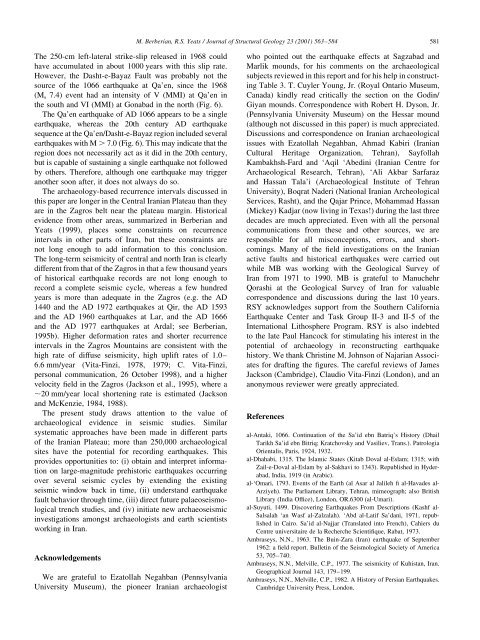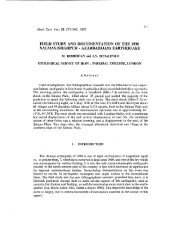PDF COPY - Manuel berberian
PDF COPY - Manuel berberian
PDF COPY - Manuel berberian
Create successful ePaper yourself
Turn your PDF publications into a flip-book with our unique Google optimized e-Paper software.
M. Berberian, R.S. Yeats / Journal of Structural Geology 23 (2001) 563±584 581The 250-cm left-lateral strike-slip released in 1968 couldhave accumulated in about 1000 years with this slip rate.However, the Dasht-e-Bayaz Fault was probably not thesource of the 1066 earthquake at Qa'en, since the 1968(M s 7.4) event had an intensity of V (MMI) at Qa'en inthe south and VI (MMI) at Gonabad in the north (Fig. 6).The Qa'en earthquake of AD 1066 appears to be a singleearthquake, whereas the 20th century AD earthquakesequence at the Qa'en/Dasht-e-Bayaz region included severalearthquakes with M . 7.0 (Fig. 6). This may indicate that theregion does not necessarily act as it did in the 20th century,but is capable of sustaining a single earthquake not followedby others. Therefore, although one earthquake may triggeranother soon after, it does not always do so.The archaeology-based recurrence intervals discussed inthis paper are longer in the Central Iranian Plateau than theyare in the Zagros belt near the plateau margin. Historicalevidence from other areas, summarized in Berberian andYeats (1999), places some constraints on recurrenceintervals in other parts of Iran, but these constraints arenot long enough to add information to this conclusion.The long-term seismicity of central and north Iran is clearlydifferent from that of the Zagros in that a few thousand yearsof historical earthquake records are not long enough torecord a complete seismic cycle, whereas a few hundredyears is more than adequate in the Zagros (e.g. the AD1440 and the AD 1972 earthquakes at Qir, the AD 1593and the AD 1960 earthquakes at Lar, and the AD 1666and the AD 1977 earthquakes at Ardal; see Berberian,1995b). Higher deformation rates and shorter recurrenceintervals in the Zagros Mountains are consistent with thehigh rate of diffuse seismicity, high uplift rates of 1.0±6.6 mm/year (Vita-Finzi, 1978, 1979; C. Vita-Finzi,personal communication, 26 October 1998), and a highervelocity ®eld in the Zagros (Jackson et al., 1995), where a,20 mm/year local shortening rate is estimated (Jacksonand McKenzie, 1984, 1988).The present study draws attention to the value ofarchaeological evidence in seismic studies. Similarsystematic approaches have been made in different partsof the Iranian Plateau; more than 250,000 archaeologicalsites have the potential for recording earthquakes. Thisprovides opportunities to: (i) obtain and interpret informationon large-magnitude prehistoric earthquakes occurringover several seismic cycles by extending the existingseismic window back in time, (ii) understand earthquakefault behavior through time, (iii) direct future palaeoseismologicaltrench studies, and (iv) initiate new archaeoseismicinvestigations amongst archaeologists and earth scientistsworking in Iran.AcknowledgementsWe are grateful to Ezatollah Negahban (PennsylvaniaUniversity Museum), the pioneer Iranian archaeologistwho pointed out the earthquake effects at Sagzabad andMarlik mounds, for his comments on the archaeologicalsubjects reviewed in this report and for his help in constructingTable 3. T. Cuyler Young, Jr. (Royal Ontario Museum,Canada) kindly read critically the section on the Godin/Giyan mounds. Correspondence with Robert H. Dyson, Jr.(Pennsylvania University Museum) on the Hessar mound(although not discussed in this paper) is much appreciated.Discussions and correspondence on Iranian archaeologicalissues with Ezatollah Negahban, Ahmad Kabiri (IranianCultural Heritage Organization, Tehran), SayfollahKambakhsh-Fard and `Aqil `Abedini (Iranian Centre forArchaeological Research, Tehran), `Ali Akbar Sarfarazand Hassan Tala'i (Archaeological Institute of TehranUniversity), Boqrat Naderi (National Iranian ArcheologicalServices, Rasht), and the Qajar Prince, Mohammad Hassan(Mickey) Kadjar (now living in Texas!) during the last threedecades are much appreciated. Even with all the personalcommunications from these and other sources, we areresponsible for all misconceptions, errors, and shortcomings.Many of the ®eld investigations on the Iranianactive faults and historical earthquakes were carried outwhile MB was working with the Geological Survey ofIran from 1971 to 1990. MB is grateful to ManuchehrQorashi at the Geological Survey of Iran for valuablecorrespondence and discussions during the last 10 years.RSY acknowledges support from the Southern CaliforniaEarthquake Center and Task Group II-3 and II-5 of theInternational Lithosphere Program. RSY is also indebtedto the late Paul Hancock for stimulating his interest in thepotential of archaeology in reconstructing earthquakehistory. We thank Christine M. Johnson of Najarian Associatesfor drafting the ®gures. The careful reviews of JamesJackson (Cambridge), Claudio Vita-Finzi (London), and ananonymous reviewer were greatly appreciated.Referencesal-Antaki, 1066. Continuation of the Sa'id ebn Batriq's History (DhailTarikh Sa'id ebn Bitriq; Kratchovsky and Vasiliev, Trans.). PatrologiaOrientalis, Paris, 1924, 1932.al-Dhahabi, 1315. The Islamic States (Kitab Doval al-Eslam; 1315; withZail-e-Doval al-Eslam by al-Sakhavi to 1343). Republished in Hyderabad,India, 1919 (in Arabic).al-`Omari, 1793. Events of the Earth (al Asar al Jalileh ® al-Havades al-Arziyeh). The Parliament Library, Tehran, mimeograph; also BritishLibrary (India Of®ce), London, OR.6300 (al-Umari).al-Suyuti, 1499. Discovering Earthquakes From Descriptions (Kashf al-Salsalah `an Wasf al-Zalzalah). `Abd al-Latif Sa'dani, 1971, republishedin Cairo. Sa'id al-Najjar (Translated into French), Cahiers duCentre universitaire de la Recherche Scienti®que, Rabat, 1973.Ambraseys, N.N., 1963. The Buin-Zara (Iran) earthquake of September1962: a ®eld report. Bulletin of the Seismological Society of America53, 705±740.Ambraseys, N.N., Melville, C.P., 1977. The seismicity of Kuhistan, Iran.Geographical Journal 143, 179±199.Ambraseys, N.N., Melville, C.P., 1982. A History of Persian Earthquakes.Cambridge University Press, London.







